

Compact Muon Solenoid
LHC, CERN
| CMS-PAS-HIN-18-017 | ||
| Measurement of prompt D+s production in pp and PbPb collisions at √sNN= 5.02 TeV | ||
| CMS Collaboration | ||
| November 2019 | ||
| Abstract: The transverse momentum (pT) spectra of prompt D+s mesons and charge conjugates are measured in pp and PbPb collisions at a center-of-mass energy of 5.02 TeV per nucleon pair using the CMS detector at the LHC. The measurement is performed through the D+s→ϕπ+→K+K−π+ decay channels with the D+s rapidity range |y|< 1.0 . The D+s production in the pT range from 2 (6) GeV/c to 40 GeV/c in pp (PbPb) collisions is measured. Suppression of the D+s nuclear modification factor (RAA) in PbPb collisions suggests a strong interaction between charm quarks and the quark-gluon plasma. The double ratio of prompt D+s to prompt D0 production in pp and PbPb is consistent with a PHSD model calculation and consistent with unity, which indicates that strange charm meson enhancement in PbPb collisions is not significant in the measured D+s pT interval. | ||
| Links: CDS record (PDF) ; inSPIRE record ; CADI line (restricted) ; | ||
| Figures | |
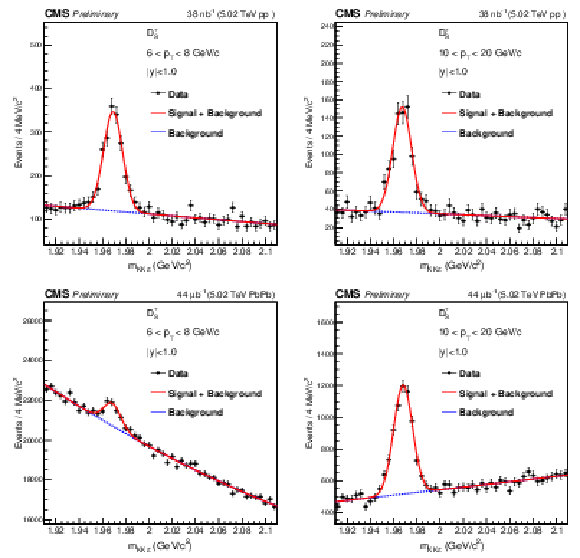
png pdf |
Figure 1:
Invariant mass distributions of D+s candidates with pT= 6-8 GeV/c (left) and 10-20 GeV/c (right) in pp (top) and PbPb (bottom) collisions at 5.02 TeV. The red solid line represents the full fit and the blue dashed line represents the background component. |
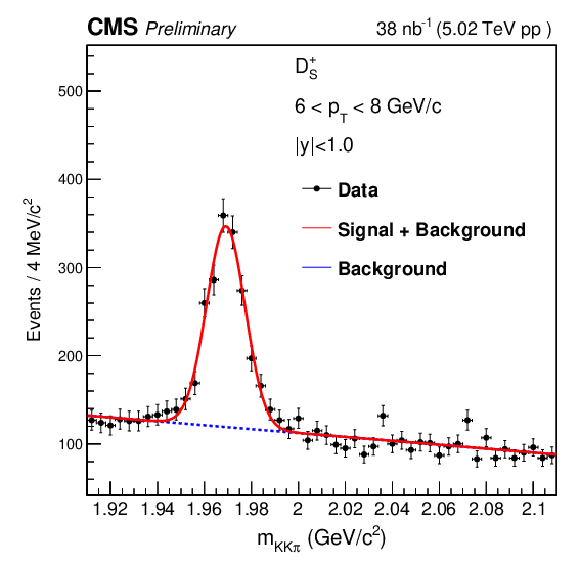
png pdf |
Figure 1-a:
Invariant mass distributions of D+s candidates with pT= 6-8 GeV/c (left) and 10-20 GeV/c (right) in pp (top) and PbPb (bottom) collisions at 5.02 TeV. The red solid line represents the full fit and the blue dashed line represents the background component. |
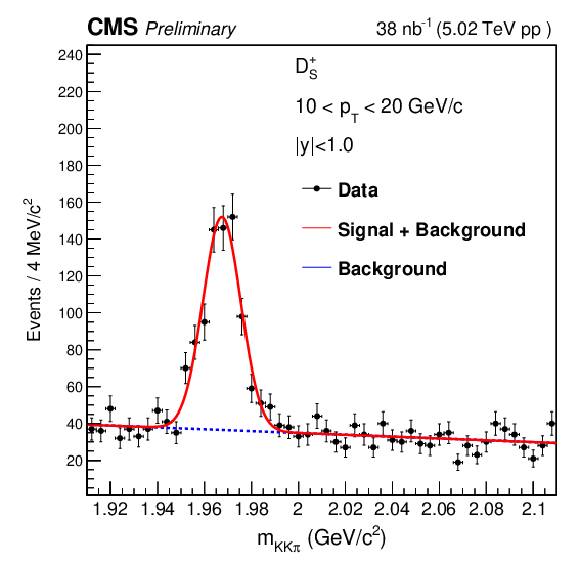
png pdf |
Figure 1-b:
Invariant mass distributions of D+s candidates with pT= 6-8 GeV/c (left) and 10-20 GeV/c (right) in pp (top) and PbPb (bottom) collisions at 5.02 TeV. The red solid line represents the full fit and the blue dashed line represents the background component. |
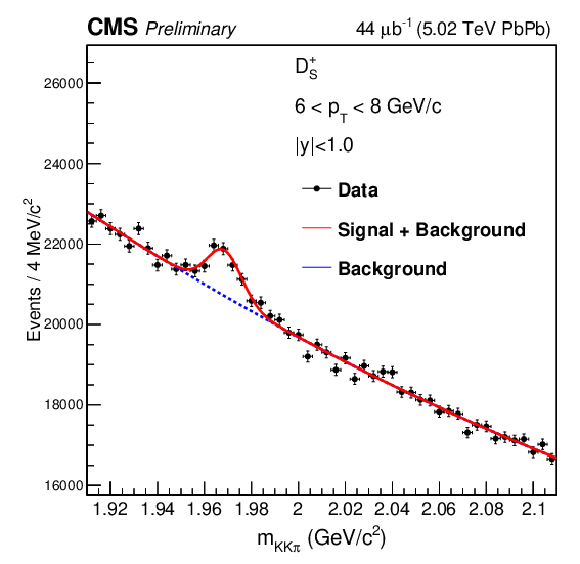
png pdf |
Figure 1-c:
Invariant mass distributions of D+s candidates with pT= 6-8 GeV/c (left) and 10-20 GeV/c (right) in pp (top) and PbPb (bottom) collisions at 5.02 TeV. The red solid line represents the full fit and the blue dashed line represents the background component. |
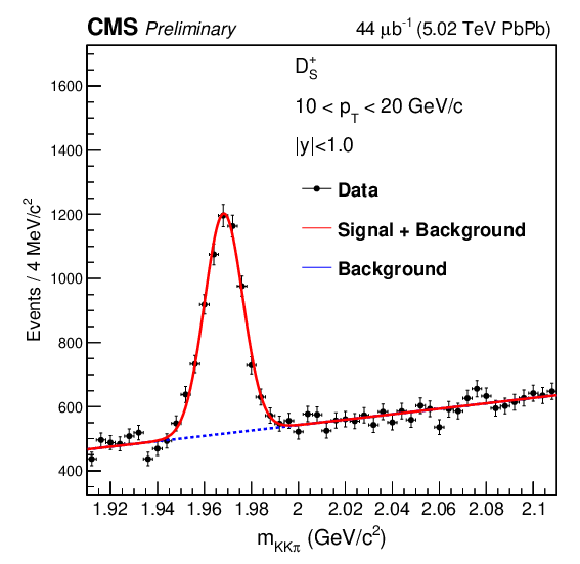
png pdf |
Figure 1-d:
Invariant mass distributions of D+s candidates with pT= 6-8 GeV/c (left) and 10-20 GeV/c (right) in pp (top) and PbPb (bottom) collisions at 5.02 TeV. The red solid line represents the full fit and the blue dashed line represents the background component. |
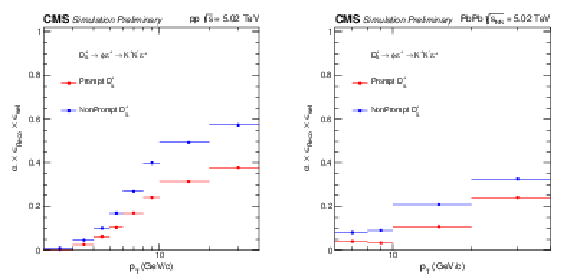
png pdf |
Figure 2:
Product of acceptance and efficiency for prompt D+s (Red) and nonprompt D+s (Blue) as a function of pT in pp (left) and PbPb (right) collisions at 5.02 TeV. |
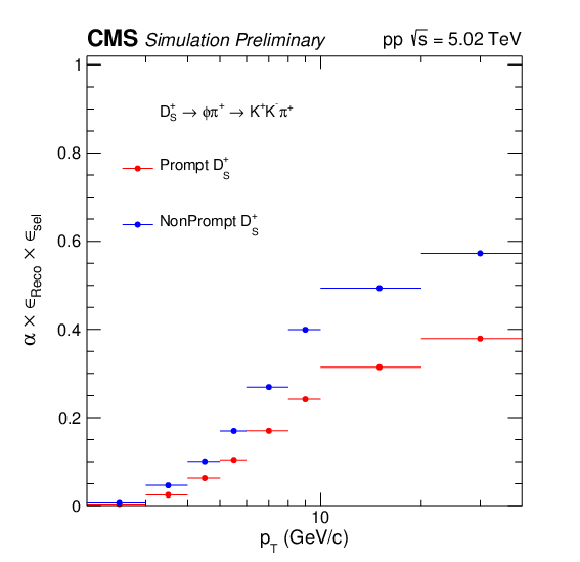
png pdf |
Figure 2-a:
Product of acceptance and efficiency for prompt D+s (Red) and nonprompt D+s (Blue) as a function of pT in pp (left) and PbPb (right) collisions at 5.02 TeV. |
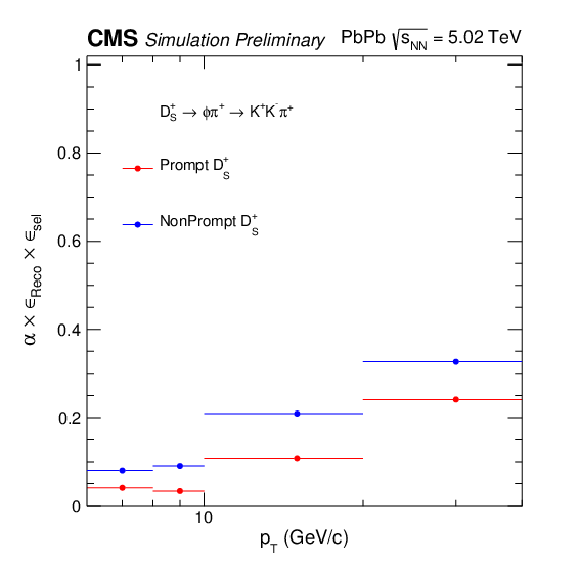
png pdf |
Figure 2-b:
Product of acceptance and efficiency for prompt D+s (Red) and nonprompt D+s (Blue) as a function of pT in pp (left) and PbPb (right) collisions at 5.02 TeV. |
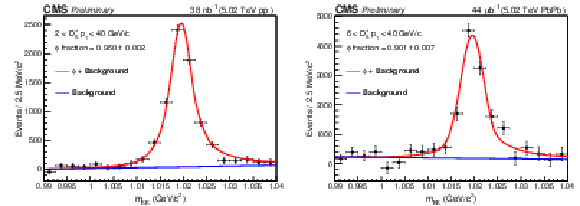
png pdf |
Figure 3:
Invariant mass fit of kaon pair of D+s candidate in pp (left) and PbPb (right) collisions at 5.02 TeV. |
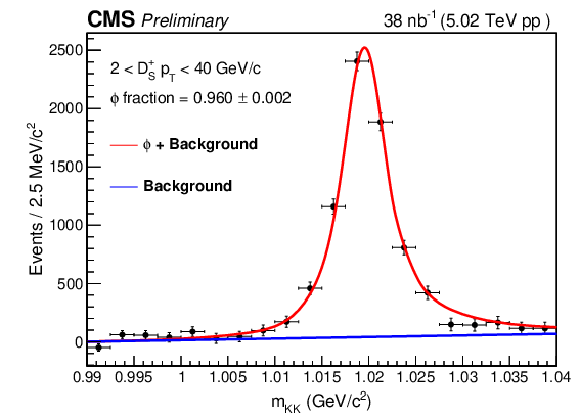
png pdf |
Figure 3-a:
Invariant mass fit of kaon pair of D+s candidate in pp (left) and PbPb (right) collisions at 5.02 TeV. |
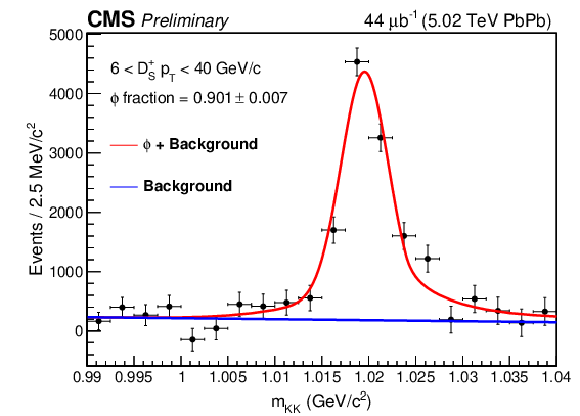
png pdf |
Figure 3-b:
Invariant mass fit of kaon pair of D+s candidate in pp (left) and PbPb (right) collisions at 5.02 TeV. |
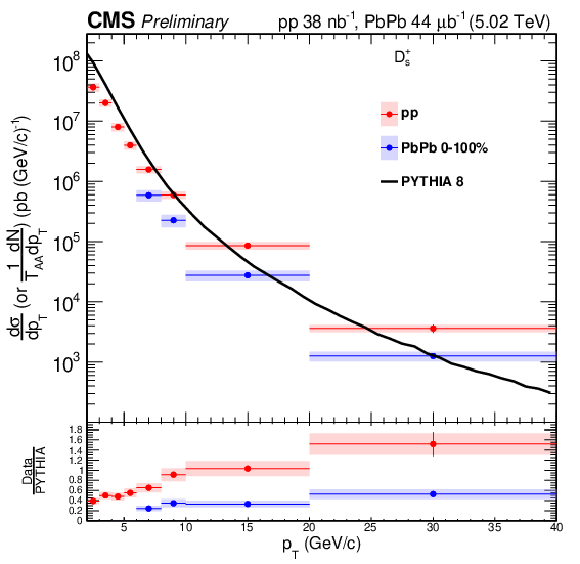
png pdf |
Figure 4:
pT differential cross section of D+s in pp and PbPb at 5.02 TeV. The vertical bars (boxes) represent the statistical (systematic) uncertainties. The red dots reprsent pT-differential cross section of D+s in pp collisions and the blue dots represnt pT-differential corrected yield of D+s mesons scaled by TAA in PbPb collisions. The black solid line represent the PYTHIA 8 calculation. The lower panel shows the ratio between data and PYTHIA 8 calculation. |
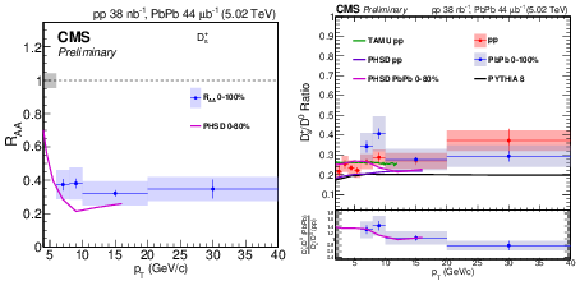
png pdf |
Figure 5:
(left) nuclear modification factor of D+s (right) D+s/D0 in pp and PbPb. The vertical bars (boxes) represent the statistical (systematic) uncertainties. The lower panel shows the double ratio of D+s/D0 in PbPb over in pp. The magenta and violet lines show the PHSD [59] [60] calculation, and the green line shows the TAMU [61] calculation. The global systematic uncertainty is represented by the grey box at RAA= 1. |
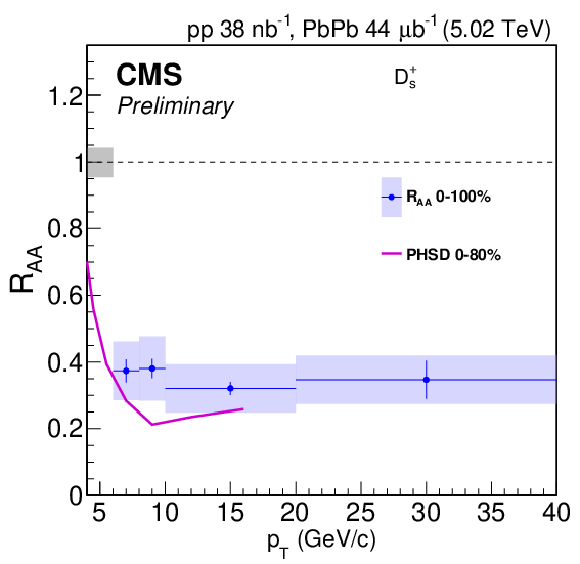
png pdf |
Figure 5-a:
(left) nuclear modification factor of D+s (right) D+s/D0 in pp and PbPb. The vertical bars (boxes) represent the statistical (systematic) uncertainties. The lower panel shows the double ratio of D+s/D0 in PbPb over in pp. The magenta and violet lines show the PHSD [59] [60] calculation, and the green line shows the TAMU [61] calculation. The global systematic uncertainty is represented by the grey box at RAA= 1. |
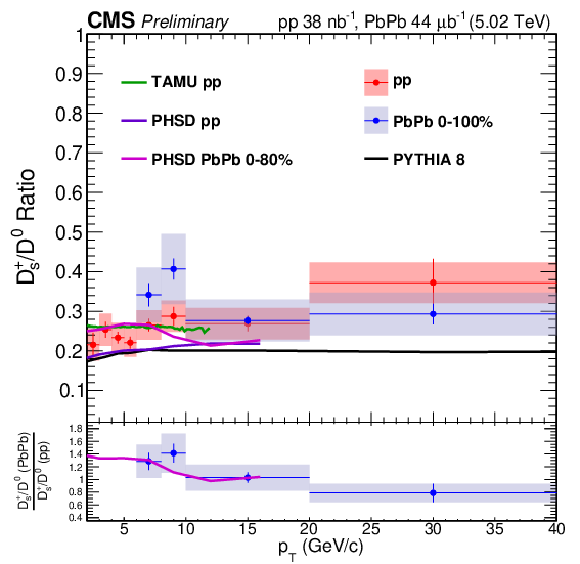
png pdf |
Figure 5-b:
(left) nuclear modification factor of D+s (right) D+s/D0 in pp and PbPb. The vertical bars (boxes) represent the statistical (systematic) uncertainties. The lower panel shows the double ratio of D+s/D0 in PbPb over in pp. The magenta and violet lines show the PHSD [59] [60] calculation, and the green line shows the TAMU [61] calculation. The global systematic uncertainty is represented by the grey box at RAA= 1. |
| Tables | |
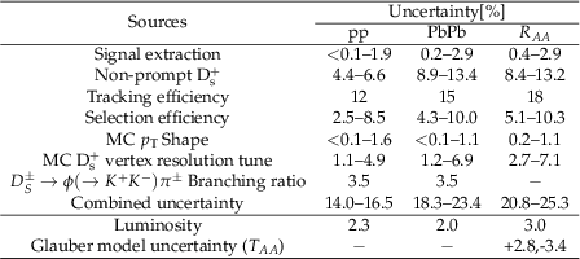
png pdf |
Table 1:
Summary of systematic uncertainties. The ranges quoted cover the pT bins. |
| Summary |
| In this note, the pT-differential cross sections of prompt Ds mesons and prompt Ds nuclear modification factors in central rapidity (|y|< 1) in pp and PbPb collisions at √sNN= 5.02 TeV are presented. The prompt Ds pT-differential cross section in pp is found to be significantly lower than PYTHIA 8 calculations. The nuclear modification of prompt Ds is below unity which indicates strong interaction between charm quarks and the QGP medium. The ratio of prompt Ds/D0 in pp is consistent with PYTHIA 8 and model calculations. The double ratio of prompt Ds/D0 in PbPb over pp is consistent with unity, which is in agreement with the PHSD calculation. The Ds production in PbPb collsions do not show a significant enhancement relative to in pp collisions in the measured pT range. Low pT measurements with higher precision from the upcoming high-luminosity LHC heavy-ion runs could provide clearer information about the charm quark hadronization in QGP. |
| References | ||||
| 1 | D. J. Gross and F. Wilczek | Ultraviolet behavior of non-abelian gauge theories | PRL 30 (Jun, 1973) 1343 | |
| 2 | F. Karsch | Lattice simulations of the thermodynamics of strongly interacting elementary particles and the exploration of new phases of matter in relativistic heavy ion collisions | Journal of Physics: Conference Series 46 (sep, 2006) 122 | |
| 3 | \'E. V. Shuryak | Theory of hadron plasma | Sov. Phys. JETP 47 (1978)212 | |
| 4 | J. C. Collins and M. J. Perry | Superdense matter: Neutrons or asymptotically free quarks? | PRL 34 (1975) 1353 | |
| 5 | F. Karsch and E. Laermann | Thermodynamics and in-medium hadron properties from lattice QCD | in Quark-Gluon Plasma III, R. Hwa, ed 2003 | hep-lat/0305025 |
| 6 | STAR Collaboration | Experimental and theoretical challenges in the search for the quark-gluon plasma: The star collaboration's critical assessment of the evidence from rhic collisions | Nuclear Physics A 757 (2005) 102, . First Three Years of Operation of RHIC | |
| 7 | K. Adcox et al. | Formation of dense partonic matter in relativistic nucleus-nucleus collisions at rhic: Experimental evaluation by the phenix collaboration | Nuclear Physics A 757 (2005) 184, . First Three Years of Operation of RHIC | |
| 8 | B. Muller, J. Schukraft, and B. Wys\louch | First Results from Pb+Pb Collisions at the LHC | Annual Review of Nuclear and Particle Science 62 (2012) 361 | |
| 9 | R. Baier, D. Schiff, and B. G. Zakharov | Energy Loss in Perturbative QCD | Annual Review of Nuclear and Particle Science 50 (2000) 37 | |
| 10 | E. Braaten and M. H. Thoma | Energy loss of a heavy quark in the quark-gluon plasma | PRD 44 (Nov, 1991) R2625 | |
| 11 | M. H. Thoma and M. Gyulassy | Quark damping and energy loss in the high temperature QCD | Nuclear Physics B 351 (1991) 491 | |
| 12 | R. Baier and Yu.L. Dokshitzer and A.H. Mueller and S. Peign\'e and D. Schiffi | Radiative energy loss and p⊥-broadening of high energy partons in nuclei | Nuclear Physics B 484 (1997) 265 | |
| 13 | Miklos Gyulassy and Michael Plumer | Jet quenching in dense matter | Physics Letters B 243 (1990) 432 | |
| 14 | M. L. Miller, K. Reygers, S. J. Sanders, and P. Steinberg | Glauber modeling in high energy nuclear collisions | Ann. Rev. Nucl. Part. Sci. 57 (2007) 205 | nucl-ex/0701025 |
| 15 | F. Prino and R. Rapp | Open heavy flavor in QCD matter and in nuclear collisions | Journal of Physics G: Nuclear and Particle Physics 43 (aug, 2016) 093002 | |
| 16 | ALICE Collaboration | Centrality dependence of high-pT D meson suppression in Pb-Pb collisions at √sNN= 2.76 TeV | Journal of High Energy Physics 11 (2015) 205 | |
| 17 | ALICE Collaboration | Transverse momentum dependence of D-meson production in Pb-Pb collisions at √sNN= 2.76 TeV | Journal of High Energy Physics 03 (2016) 081 | |
| 18 | CMS Collaboration | Nuclear modification factor of D0 mesons in PbPb collisions at √sNN= 5.02 TeV | Physics Letters B 782 (2018) 474 | |
| 19 | STAR Collaboration | Observation of D0 Meson Nuclear Modifications in Au+Au Collisions at √sNN= 200 GeV | PRL 113 (Sep, 2014) 142301 | |
| 20 | CMS Collaboration | Measurement of Prompt D0 Meson Azimuthal Anisotropy in Pb-Pb Collisions at √sNN= 5.02 TeV | PRL 120 (May, 2018) 202301 | |
| 21 | ALICE Collaboration | D-Meson Azimuthal Anisotropy in Midcentral Pb-Pb Collisions at √sNN= 5.02 TeV | PRL 120 (Mar, 2018) 102301 | |
| 22 | STAR Collaboration | Measurement of D0 azimuthal anisotropy at midrapidity in Au+Au collisions at √sNN= 200 GeV | PRL 118 (May, 2017) 212301 | |
| 23 | J. Rafelski and B. Muller | Strangeness Production in the Quark - Gluon Plasma | PRL 48 (1982) 1066, .[Erratum: PRLett.56,2334(1986)] | |
| 24 | STAR Collaboration | Strangeness Enhancement in Cu-Cu and Au-Au Collisions at √sNN= 200 GeV | PRL 108 (Feb, 2012) 072301 | |
| 25 | STAR Collaboration | Enhanced strange baryon production in Au+Au collisions compared to p+p at √sNN= 200 GeV | PRC 77 (Apr, 2008) 044908 | |
| 26 | ALICE Collaboration | Multi-strange baryon production at mid-rapidity in Pb-Pb collisions at √sNN= 2.76 TeV | Physics Letters B 728 (2014) 216 | |
| 27 | V. Greco, C. M. Ko, and P. Levai | Partonic coalescence in relativistic heavy ion collisions | PRC 68 (Sep, 2003) 034904 | |
| 28 | V. Greco, C. Ko, and R. Rapp | Quark coalescence for charmed mesons in ultrarelativistic heavy-ion collisions | Physics Letters B 595 (2004) 202 | |
| 29 | I. Kuznetsova and J. Rafelski | Charmed hadrons from strangeness-rich QGP | Journal of Physics G: Nuclear and Particle Physics 32 (nov, 2006) S499 | |
| 30 | CMS Collaboration | Measurement of B0s meson production in pp and PbPb collisions at √sNN= 5.02 TeV | Physics Letters B 796 (2019) 168 | |
| 31 | ALICE Collaboration | Λ+c production in Pb-Pb collisions at √sNN= 5.02 TeV | Physics Letters B 793 (2019) 212 | |
| 32 | CMS Collaboration | Production of Λ+c baryons in proton-proton and lead-lead collisions at √sNN= 5.02 TeV | 2019 | |
| 33 | ALICE Collaboration | Measurement of D0, D+, D∗+ and D+s production in Pb-Pb collisions at √sNN= 5.02 TeV | Journal of High Energy Physics 2018 (Oct, 2018) 174 | |
| 34 | CMS Collaboration | Studies of Beauty Suppression via Nonprompt D0 Mesons in Pb-Pb Collisions at √sNN= 5.02 TeV | PRL 123 (Jul, 2019) 022001 | |
| 35 | CMS Collaboration | Measurement of the B Meson Nuclear Modification Factor in Pb-Pb Collisions at √sNN= 5.02 TeV | PRL 119 (Oct, 2017) 152301 | |
| 36 | CMS Collaboration | Measurement of prompt and nonprompt charmonium suppression in PbPb collisions at 5.02 TeV | The European Physical Journal C 78 (Jun, 2018) 509 | |
| 37 | CMS Collaboration | Description and performance of track and primary-vertex reconstruction with the CMS tracker | JINST 9 (2014) P10009 | CMS-TRK-11-001 1405.6569 |
| 38 | CMS Collaboration | The CMS trigger system | JINST 12 (2017) P01020 | CMS-TRG-12-001 1609.02366 |
| 39 | CMS Collaboration | The CMS experiment at the CERN LHC | JINST 3 (2008) S08004 | CMS-00-001 |
| 40 | CMS Collaboration | Charged-particle nuclear modification factors in PbPb and pPb collisions at √sNN= 5.02 TeV | JHEP 04 (2017) 039 | CMS-HIN-15-015 1611.01664 |
| 41 | CMS Collaboration | Transverse momentum and pseudorapidity distributions of charged hadrons in pp collisions at √s= 0.9 and 2.36 TeV | JHEP 02 (2010) 041 | CMS-QCD-09-010 1002.0621 |
| 42 | T. Sjostrand et al. | An Introduction to PYTHIA 8.2 | CPC 191 (2015) 159 | 1410.3012 |
| 43 | CMS Collaboration | Event generator tunes obtained from underlying event and multiparton scattering measurements | EPJC 76 (2016) 155 | CMS-GEN-14-001 1512.00815 |
| 44 | GEANT4 Collaboration | GEANT4 --- a simulation toolkit | NIMA 506 (2003) 250 | |
| 45 | D. J. Lange | The evtgen particle decay simulation package | NIM Section A: Accelerators, Spectrometers, Detectors and Associated Equipment 462 (2001) 152, BEAUTY2000 | |
| 46 | I. P. Lokhtin and A. M. Snigirev | A model of jet quenching in ultrarelativistic heavy ion collisions and high-pT hadron spectra at RHIC | EPJC 45 (2006) 211 | hep-ph/0506189 |
| 47 | Particle Data Group, C. Patrignani et al. | Review of Particle Physics | CPC 40 (2016) 100001 | |
| 48 | H. Voss, A. Hocker, J. Stelzer, and F. Tegenfeldt | TMVA, the toolkit for multivariate data analysis with ROOT | in XIth International Workshop on Advanced Computing and Analysis Techniques in Physics Research (ACAT) | physics/0703039 |
| 49 | W. Verkerke and D. P. Kirkby | The RooFit toolkit for data modeling | eConf C0303241 (2003) MOLT007, [,186(2003)] | physics/0306116 |
| 50 | LHCb Collaboration | Measurement of B meson production cross-sections in proton-proton collisions at √s= 7 TeV | JHEP 08 (2013) 117 | 1306.3663 |
| 51 | Y. Amhis et al. | Averages of b-hadron, c-hadron, and tau-lepton properties as of summer 2016 | The European Physical Journal C 77 (Dec, 2017) 895 | |
| 52 | M. Cacciari, M. Greco, and P. Nason | The P(T) spectrum in heavy flavor hadroproduction | JHEP 05 (1998) 007 | hep-ph/9803400 |
| 53 | M. He, R. J. Fries, and R. Rapp | Heavy-quark diffusion and hadronization in quark-gluon plasma | PRC 86 (2012) 014903 | 1106.6006 |
| 54 | M. He, R. J. Fries, and R. Rapp | Heavy flavor at the large hadron collider in a strong coupling approach | PLB 735 (2014) 445 | 1401.3817 |
| 55 | M. Cacciari, M. Greco, and P. Nason | The pT spectrum in heavy flavor hadroproduction | JHEP 05 (1998) 007 | hep-ph/9803400 |
| 56 | PHENIX Collaboration | Detailed measurement of the e+e− pair continuum in p+p and Au+Au collisions at √sNN= 200 GeV and implications for direct photon production | PRC 81 (Mar, 2010) 034911 | |
| 57 | H. D. Vries, C. D. Jager, and C. D. Vries | Nuclear charge-density-distribution parameters from elastic electron scattering | Atomic Data and Nuclear Data Tables 36 (1987) 495 | |
| 58 | CMS Collaboration | CMS Luminosity Calibration for the pp Reference Run at √s= 5.02 TeV | CMS-PAS-LUM-16-001 | CMS-PAS-LUM-16-001 |
| 59 | T. Song et al. | Tomography of the quark-gluon plasma by charm quarks | PRC 92 (Jul, 2015) 014910 | |
| 60 | T. Song et al. | Charm production in Pb + Pb collisions at energies available at the CERN Large Hadron Collider | PRC 93 (Mar, 2016) 034906 | |
| 61 | M. He and R. Rapp | Charm-baryon production in proton-proton collisions | Physics Letters B 795 (2019) 117 | |

|
Compact Muon Solenoid LHC, CERN |

|

|

|

|

|

|